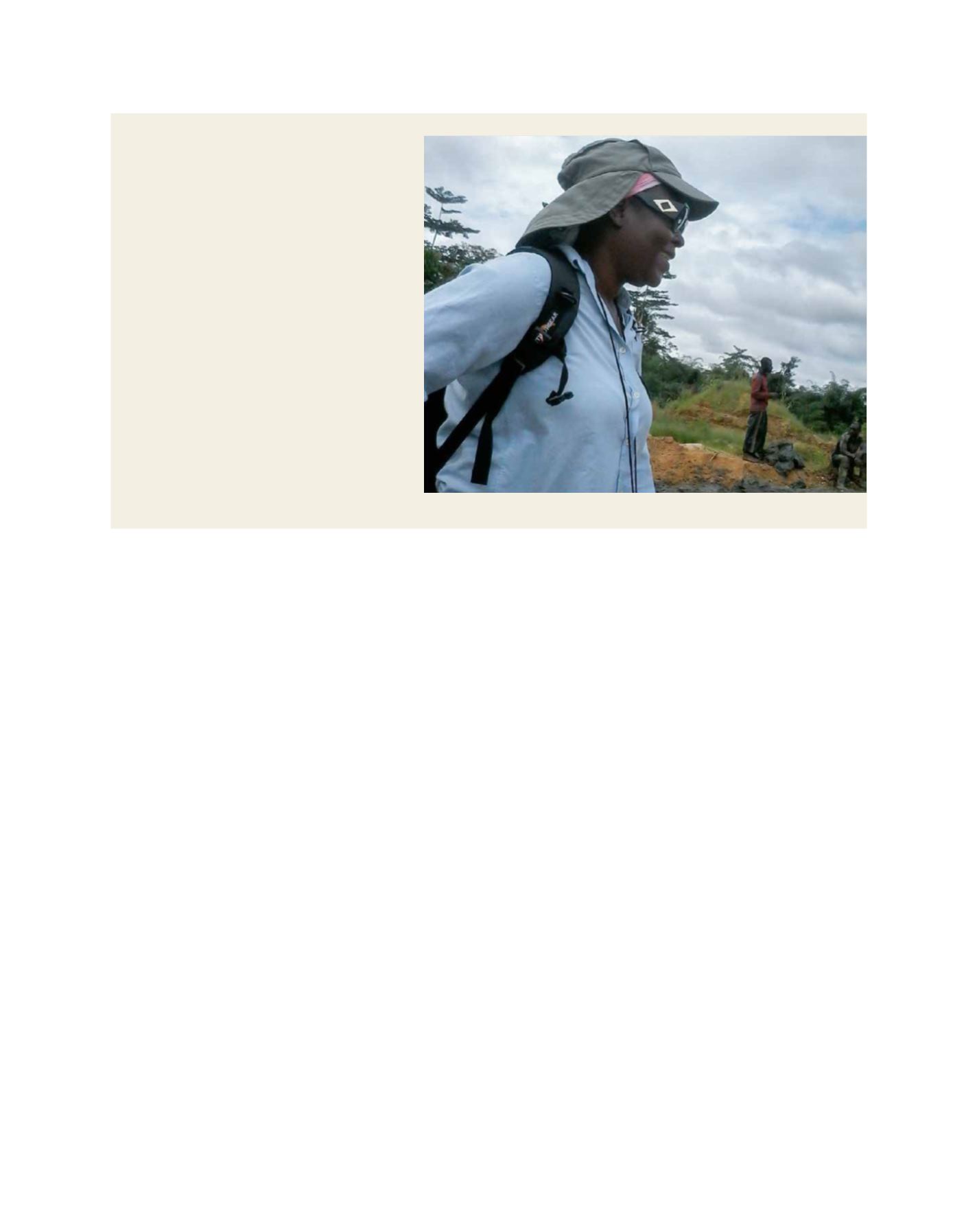

Profile: Amina
Amina is a small-scale miner who owns several
alluvial gold concessions in the eastern and central
regions of Ghana.
Amina’s 30 permanent staff are all men, for whom
she pays salaries, Social Security and National
Insurance Trust, and medical bills. About 60 per cent
of her 100-plus temporary workers or contractors are
women, who are paid based on the amount of gold
they make.
“I started as a gold buyer because I saw it as very
lucrative,” Amina says. “A concession owner cheated
me and I seized his land and mined it to get my money
back. Following that, I applied for and obtained a
concession from the Minerals Commission and started
my own small-scale mine. I applied for a licence, which
took a long time, but it finally came. I also did an
environmental impact assessment of the site.”
Amina has not engaged the services of surveyors
because she believes that she intuitively knows where
the gold is located. According to an exploration team
from the village, 40 per cent of Amina’s 50-acre
concession at Kwabeng is minable, and the mine has
a projected life of two years.
“I do not know the total resource,” Amina says. “I
mine it step by step depending on which farmer gives
me the access.”
[
] 71
their ventures. Regionally, the overarching Agenda 2063
recognizes lack of access to productive resource as a key
limitation to women’s engagement in the economic sector,
and has set an ambitious target of levelling the playing field
of gender equality by 2020 (and providing about 90 per
cent access to productive resource for women in its 10-year
implementation plan.
1
In terms of the poverty-wealth nexus, the data gath-
ered for the research suggested that most women get into
ASM because of poverty, with only a small proportion of
respondents entering because of the subsector’s wealth
creation potential. Scholars have alluded to the stronghold
of poverty as the major driver in ASM.
2
In this regard,
when women enter ASM with limited understanding of the
sector and the mentality of getting rich quickly (especially
in the gold and gemstone industry), the drive changes to
wealth creation without them having adequately prepared
themselves. The fine line between preparation and lack of
preparation by those who enter for wealth creation makes a
difference in how women are able to engage in the subsec-
tor. Women in Ghana, Zimbabwe, South Africa and others
told how they learned within a short time to adequately
prepare and understand how the subsector works and, with
some (although little) government intervention, have been
able to reap compounded benefits from mining. The fine
nexus between poverty and wealth, and lack of preparation
in terms of understanding the fundamental requirements,
limit women’s effective participation in mining. Broadly,
however, the nexus is tied to the added advantage of educa-
tion, socioeconomic status, and support structures to boost
women’s capacity for mining.
Women’s often limited level of education, awareness
and access to knowledge constrains their roles in the
ASM subsector and their potential economic empower-
ment. Many women are not aware of the laws governing
mining activities, including the processes related to mining
licences, environmental management requirements, health
and safety regulations and practices, mining value and
supply chains, and business development and implemen-
tation strategies. Across Africa, women’s low levels of
literacy and education affect their ability to gain the tech-
nical knowledge that would help them manage their mining
operations and access the higher levels of the ASM value
chain. It also translates into a limited number of women
who can act as role models. In essence, ASM enterprises are
small businesses with the associated challenges of accessing
finance, developing business plans, developing and manag-
ing business, marketing and sales.
Being able to tally the numbers aids in effective planning.
However, most of the numbers of ASM are ‘guesstimates’,
and in all six countries, the agencies show different
numbers/statistics on the actual operators within ASM.
Effective development planning starts with a strategy which
accounts for who, where, what and how to address the
needs of a sector. Without knowing the actual numbers of
the diverse groups of women involved in different aspects
of the mining value chain, most attempts at formalization
would be unsuccessful. Tanzania, a classic example of a
country with some known and verifiable data, conducted
a baseline survey of the subsector in 2011. When it devel-
oped its Five Year Development Plan 2011/12-2015/16,
it committed to leasing mining equipment to small-scale
miners, developing medium-scale miners and providing
quasi banking institutions to address the needs of women
in the sector through innovative forms of financing such
as rotating savings and credit, community cooperatives and
Amina has been in the mining business for 10 years
Image: ECA
G
ender
E
quality
and
W
omen
’
s
E
mpowerment
















